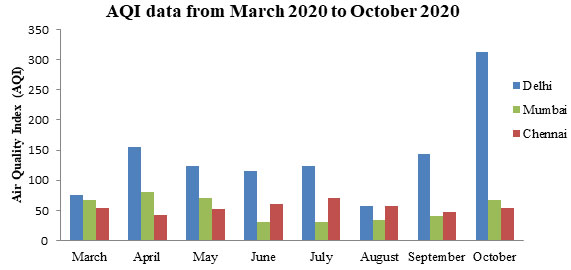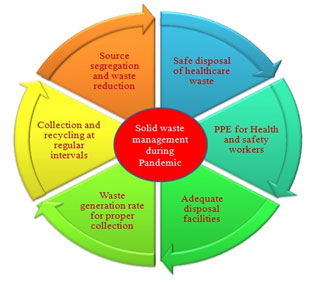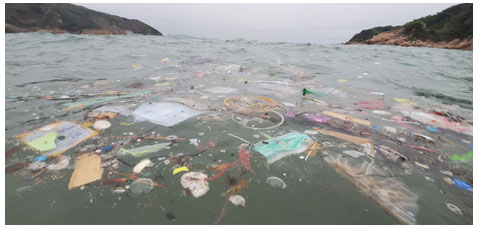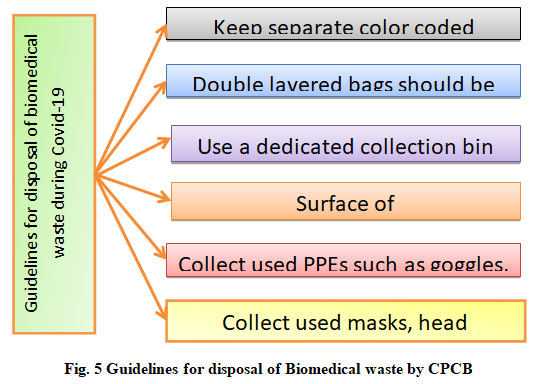1Department of Civil Engineering, Sri Manakula Vinayagar
Engineering College, Pudhucherry, India.
2Department of Computer Science and Engineering, University
College of Engineering Villupuram, India.
Corresponding author email: sinthanaswaminathan@gmail.com
Article Publishing History
Received: 21/07/2021
Accepted After Revision: 23/09/2021
The Corona Virus Disease 2019 (COVID-19) is an acute virus creating respiratory disease and gastro intestine disease in humans. The outbreak of novel corona virus (COVID-19) has brought serious impact on all counties around the world. Spread of COVID-19 was controlled by countries through restricted movement, self-hygiene practices and social distancing. Despite all the efforts made by the governments, this pandemic brought serious effect on economy and environment. The impacts of COVID-19 on air, water and waste management were assessed and were observed that air and water quality has improved due to lockdown but the management of waste is a serious issue. This article describes the results of study performed on the environmental effects particularly in air and water by assessing the environmental conditions before and after the outbreak of pandemic COVID-19.
The study results yields that the purity of air and water has been improved during the pandemic period when compared with the period before the outbreak of COVID-19 virus. Waste generated from self-quarantine houses, hospitals and self-hygiene practices followed by people has posed an enormous effect on waste management sector. Disposal of infectious waste along with municipal solid waste has created threat to people handling the waste and the environment. Based on the environmental analysis performed on air, water and waste management, solid guidelines has been provided in treating the waste management effectively. This article recommends the need for improving the waste treatment methodology and the significances of policy framework to face pandemic situation in future. This study improves the hope that, implementation of proposed guidelines will improve the purity level of environment and management of biomedical wastes effectively.
COVID-19, Environmental analysis, Pollution assessment, Waste management, Municipal solid waste.
Swaminathan S.G, Rajendran R. Environmental Effects of COVID-19 in India: A Qualitative Analysis. Biosc.Biotech.Res.Comm. 2021;14(3).
Swaminathan S.G, Rajendran R. Environmental Effects of COVID-19 in India: A Qualitative Analysis. Biosc.Biotech.Res.Comm. 2021;14(3). Available from: <a href=”https://bit.ly/3m1xeAz“>https://bit.ly/3m1xeAz</a>
Copyright © Swaminathan and Rajendran This is an open access article distributed under the terms of the Creative Commons Attribution License (CC-BY) https://creativecommns.org/licenses/by/4.0/, which permits unrestricted use distribution and reproduction in any medium, provide the original author and source are credited.
INTRODUCTION
The outbreak of corona virus (COVID – 19) as a pandemic has brought a serious impact on environmental health and economy. Corona virus was found to be spread from a seafood market in Wuhan, China. Then its effect was seen across countries due to human-to human transmission in short period (Sarkodie and Owusu 2020; WHO 2020c). In January 2020, WHO (World Health Organization) found that transmission of COVID-19 is through respiratory droplets (WHO, 2020).
In February, rise of corona cases started in Iran, Italy and different nations around the world. Due to the short period of transmission, WHO declared COVID-19 as pandemic. By the end of March, half of the human population was under different forms of lockdown (Tosepu et al. 2020). This transmissible disease spread across 114 countries by 118,000 cases and 4291 deaths (Sarkodie and Owusu 2020; WHO 2020e).
As of October 25, 2020, there were 34,804,348 reported cases about the globe of which 1,030, 738 deaths were recorded alongside 7,733,778 active cases and 27,665,198 recovered cases. Now, the USA has the greater number of cases (7,256,234) and deaths (207,366) among 235 countries, followed by India (6,549,373 confirmed cases and 101,782 deaths), Brazil (4,880,523 confirmed cases and 145,388 deaths), Russia (1,215,001 confirmed cases and 21,358 deaths), Colombia (841,531 confirmed cases and 26,397 deaths) and Peru (821,534 confirmed cases and 32,609 deaths).
Total number of deaths in top ten countries due to novel corona virus has been represented in figure 1. Corona virus (COVID-19) has brought worldwide discussion and uncertainty compared to SARS (2002–2003), Avian flu (2003–2009), Swine flu (2009–2010) and Ebola (2014–2016) since 1996 (Ahir et al. 2018). Even the health care systems of world’s most developed countries are on the verge of collapse (Armocida 2020).
Figure 1: Total Number of deaths in Top 10 countries

Time between catching of virus and showing up the symptoms of disease is known as incubation period. It was found that the symptoms are seen in people within 14 days, nearly around 5 days (Wang et al. 2020).
Symptoms of COVID-19 are similar to that of previous outbreak such as MERS and SARS, but the death rate is high compared to them (Wang et al. 2020). Transmission of corona virus is due to the droplets formed due to coughing, sneezing, speaking and accidently inhaling the droplets in a crowded proximity of an affected person. Common signs of COVID-19 are tiredness, fever, sore throat and dry cough. Some patients also have body pain, nasal blockage or diarrhea (Verma 2020). Most of the people recover without special treatment. Approximately 1 out of each 6 affected persons develops serious breathing conditions, thus needing exceptional care.
Aged people with existing medical problems such as hypertension, diabetes or heart issues are found to develop serious illness. Communication of corona virus is also due to contact of the surface which is contaminated by the infected individual. Contaminated surfaces include entryway chimes, lift catches, and steps, vegetables, organic products and so on which may interact with people often times. Certainly, even fecal matter of infected individual is discovered to be the spreading source henceforth it can reach through fecal-oral transmission (Verma 2020).
Therefore, only way of preventing the transmission of corona virus is by restricting the gathering. Compared to other diseases and their effects, COVID-19 has brought greater human agony and serious public health concern. This pandemic situation has triggered political and financial emergency in the world. As immunization for COVID-19 is not available, it has spread quickly and posed enormous health, economic, ecological and social difficulties to the whole human populace.
Thus, even large and small cities of affected nations were brought under part of total lockdown. This paper discusses about the effects of COVID-19 in air, water and waste management. This pandemic situation has brought the need of change in policy framework of waste management and hence it becomes necessary to incorporate certain rules and regulations to be followed during future pandemic situations (WHO 2020) .
Remedial Measures Taken by Government: The significances of performing remedial measures to bounce back from the pandemic situation are considered to be more vital. The government of all countries are framing security policies and imposing these policies towards the public to follow, such that to avoid the spreading of COVID-19 virus.
The government has implemented certain measures like lockdown, quarantine of COVID infected patients, restricted access to market resources, vaccinations, wearing face mask, usage of hand sanitizers and cloves in public places, spraying disinfectants to all public places and containment zones etc (Asumadu 2020). As the vaccination for COVID-19 is not available till date, the government and health care experts have proposed to impose lockdown to contain the spread of corona virus. Government has also forced some rules and regulations such as social distancing, wearing of masks, etc (Somani, 2020).
Control measures such as isolation, restriction on travel to various countries, limit of people in social gathering and occasions, closure of religious places and restriction on public transport were followed during lockdown. Lockdown posed in India, applicable for the entire population started on 25th march, 2020. Till 18th may-2020, lockdown was restored based on the prevailing conditions across the country. Based on that India had various phases of lockdown such as 21days, 14 days, 30 days and so on (Sharma 2020).
During the first phase of lockdown, there were severe restrictions such as suspension of various modes of transportation in and across the nation. This was relaxed by the government based on the number of cases prevailing in the particular area. Based on the number of cases, government categorized the entire nation into three different zones such as Red for disease hotspots, Orange for places with limited cases and green for places with nil cases (Sharma 2020). After separating the entire nation based on zones, government announced relaxations based on them from 8th June 2020. Relaxations were given on various phases from June, 2020 and they were termed as “Unlock 1.0” to “Unlock 5.0” till 31st October, 2020 (Mandal 2020).
Effect on Air: Air pollution has attributed to more than 7 million deaths across the world and around 1.4 million in India. It has been reduced considerably due to the lockdown. Restriction on travel resulted in non-movement of aircrafts and vehicles throughout the world. This resulted in decrease in harmful emissions in the atmosphere (Polk 2019; Verisk 2020). NASA satellite pictures showed a decline in the levels of nitrogen oxide by 70% because of reduction in the utilization of non-renewable energy sources during the lockdown (UCAR 2020). Carbon monoxide and aerosol concentration were also reduced (Gautam and Trivedi 2020; Holthaus 2020).
Based on the observation by the contaminant levels in the air was seen reduced in Delhi during lockdown. Rather than other contaminants, PM10 and PM2.5 was found to be reduced by around 50 % [Machado and Samina, 2020]. Due to the fall of PM2.5 concentration in the atmosphere, premature mortality rate was reduced (Venter et al. 2020). Air Quality Index (AQI) was seen throughout the nation during lockdown, it represented a reduction of about 30 % when compared to earlier year data (Sharma et al. 2020). Figure 2 and 3 represents the changes in AQI previously (September 2019 to February 2020) and after lockdown (March to October 2020) in Delhi, Mumbai and Chennai (CPCB AQI Bulletin) (Mahato and Pal 2020).
Figure 2: AQI from September 2019 to February 2020for Delhi, Mumbai and Chennai

Figure 3: AQI from March to October 2020 for Delhi, Mumbai and Chennai

Effect on Water: Lockdown has brought a reset for nature and human population. Articles from various dailies and magazines reported that there is an improvement in the quality of streams like Ganga, Cauvery, Yamuna and so on (Lokhandwala and Gautam 2020; Pathak and Mishra 2020). This improvement was seen due to the closure of industries which let their untreated effluent into the rivers. River quality parameters such as DO and BOD were considerably reduced (Pathak and Mishra 2020).
CPCB inspected the quality of various rivers in India during March and April. The river water quality was assessed on parameters pH, Dissolved Oxygen (DO), Biochemical Oxygen Demand (BOD) and Fecal Coliform (FC). The results were compared with the Primary Water Quality Criteria for Outdoor Bathing notified under Environment (Protection) Rules, 1986. As per their report submitted to National Green Tribunal (NGT) on September 16, 2020, water quality of major rivers in India was not improved significantly. As the lockdown was relaxed from June, the water quality parameters were seen to be increased due to human activities (Lokhandwala and Gautam 2020; Pathak and Mishra 2020).
Effect on Waste Generation: Though COVID-19 has brought a considerable change in air and water quality, it posed a serious effect on waste management. Increase in the quantity of waste generation was due to the isolation and stay at home practices. Not only the municipal solid waste but also the amount of biomedical waste was increased due to hygiene practices followed to prevent the spread of COVID-19. As the developing nations do not have proper waste disposal and management facilities it resulted in the improper disposal of biomedical waste. Thus proper disposal of waste with appropriate care is needed to prevent the spread of corona virus through disposed waste (Ferronato and Torretta 2019; ISWA 2020).
Inadequate maintenance and carelessness in safety measures has brought the need of the hour to safeguard biomedical waste. Proper functioning of waste management needs continuous function of workers and safety measures to be followed by them during collection to avoid spread of corona virus during collection and disposal. Appropriate handling of biomedical waste from health care facilities and households should be followed by public and health care workers. Figure 4 represents the necessary practices to be followed during pandemic situations (ISWA 2020).
Figure 4 : Solid waste management practices during Pandemic

Effect on Improper Disposal of Bio Medical Waste: During pandemic situations like COVID-19, the amount of biomedical waste generated will be high. It is due to the disposal of contaminated masks and PPE in large quantities. Improper use and disposal of masks and gloves has resulted in risk of human and aquatic life. It was also seen that face masks were disposed without proper care along the streets thus resulting in pressure on waste management system (Emily 2020). Biomedical waste management system needs proper collection, storage, transportation and disposal with proper safety measures and training (UNEP 2020).
Figure 5 : Improper disposal of face masks (Source: Independent News)

Till now, India has only limited facilities to handle and dispose the biomedical waste. It has been reported that there are only 198 common bio-medical waste treatment facilities (CBMWTFs) and 225 captive incinerators are operational in the country. Due to the sudden outbreak of COVID-19 and unexpected rise in the quantity of biomedical waste generation has brought a serious issue in handling and disposing them (Datta et al. 2018; UNEP 2020).
Present and Future of Waste Management: Measures to be taken on treatment and disposal of biomedical waste produced during treatment, determination and isolation of COVID-19 patients was proposed by the Central Pollution Control Board, New Delhi, and Government of India on March 18, 2020. It recommended that that isolation wards should maintain separate coded bins for disposal of waste. Based on their endorsements, workers dealing with disposal of biomedical waste should be given adequate training on handling and sorting them (Ramteke et al. 2020).
Figure 5a: Guidelines for disposal of Biomedical waste by CPCB

Though rules and regulations were proposed on handling and disposal of biomedical waste by the government, it’s in the hands of an individual to follow and prevent the spread of COVID-19. Hence to avoid sudden enforcement of rules and regulations, waste management during emergency situations should be made as a part of disaster planning and management. Thus, the health care workers all around the world should be trained to handle the infectious wastes. Also, proper classification of waste based on their type and nature may help in preventing unnecessary waste generation (Ramteke et al. 2020).
Corona virus has not only affected human life but also indirectly affected air, water and land. Lockdown has brought positive impact on air quality as many industries were closed and movement of vehicles were restricted. Concentrations of greenhouse gases were found to be reduced in most of the cities around the world.
Illegal disposal of effluent without treatment in rivers was reduced due to lockdown, thus enabling improvement in water quality. Most of the rivers in India are revived back to its best condition. Though COVID-19 has brought positive effects on air and water quality, its short termed and it’s the responsibility of citizens to preserve the nature which has revived itself. As to prevent the spread of corona virus people are advised to wear mask, gloves, PPE kits etc (Ramteke et al. 2020).
CONCLUSION
The findings of the present study confirms that COVID-19 pandemic has made all the developed and developing countries face severe economic and social instability. Although several measures were taken by them, the spread of COVID-19 is becoming unstoppable. Governments around the world are trying to prevent the spread of virus through lockdown, social distancing and self-hygiene practices. Improper disposal of all those has brought a serious threat to waste management.
Health care workers involved in waste management are susceptible to exposure of COVID-19. Biomedical waste quantity has increased drastically, but the disposal options are very less. Incineration facilities are used to dispose biomedical waste but it may release toxic gases in environment. Hence Government should frame necessary policies to handle pandemic situations and waste management options should be modified to adapt increased waste quantities.
Conflict Of Interests: Authors declare no conflicts of interests to disclose.
REFERENCES
Ahir, H., Bloom, N. and Furceri, D., (2018). The world uncertainty index. Available at SSRN 3275033.
Armocida, B., Formenti, B., Ussai, S., et al. (2020). The Italian health system and the COVID-19 challenge. The Lancet Public Health, 5(5), e253.
Verma, A. and Prakash, S., (2020). Impact of covid-19 on environment and society. Journal of Global Biosciences, 9(5), 7352-7363.
Central Pollution Control Board (2014), National Air Quality Index, AQI bulletin. https://app.cpcbccr.com/ccr_docs/FINAL-REPORT_AQI_.pdf
CPCB (2020), Guidelines for handling, treatment and disposal of waste generated during treatment/diagnosis/quarantine of COVID-19 patients, Central Pollution Control Board, Govt. of India. https://cpcb.nic.in/covid-waste-management/
Datta, P., Mohi, G.K., Chander, J., (2018). Biomedical waste management in India: critical appraisal. J Lab Physicians, 10 (1), 6–14.
Emily, A. (2020). UBC researchers develop biodegradable medical mask, University of British Columbia website. Retrieved from https://buff. ly/2BbeCZM
Ferronato, N., and Torretta, V., (2019). Waste mismanagement in developing countries: a review of global issues. Int. J. Environ. Res. Public Health, 16 (6), 1060.
Gautam, S., and Trivedi, U. (2020). Global implications of bio-aerosol in pandemic. Environment, Development and Sustainability, 22, 3861–3865.
Sharma, H.B., Vanapalli, K.R., Cheela, V.S., et al. (2020). Challenges, opportunities, and innovations for effective solid waste management during and post COVID-19 pandemic. Resources, Conservation and Recycling, 162, 105052.
Ma, Y., Lin, X., Wu, A., et al. (2020). Suggested guidelines for emergency treatment of medical waste during COVID-19: Chinese experience. Waste Disposal and Sustainable Energy, 1
Mandal, I. and Pal, S., (2020). COVID-19 pandemic persuaded lockdown effects on environment over stone quarrying and crushing areas. Science of the Total Environment, 732, 139281.
Somani, M., Srivastava, A.N., Gummadivalli, S.K. et al. (2020). Indirect implications of COVID-19 towards sustainable environment: an investigation in Indian context. Bioresource Technology Reports, 11, 100491.
Polk, H.S., (2019). State of Global Air 2019: A Special Report on Global Exposure to Air Pollution and Its Disease Burden. Health Effects Institute, Boston, MA.
Tosepu, R., Gunawan, J., Effendy, D.S., et al. (2020). Correlation between weather and Covid-19 pandemic in Jakarta, Indonesia. Science of the total environment, 725, 138436.
Ramteke, S. and Sahu, B.L., (2020). Novel coronavirus disease 2019 (COVID-19) pandemic: considerations for the biomedical waste sector in India. Case Studies in Chemical and Environmental Engineering, 2, 100029.
Pathak, S.S. and Mishra, P., (2020). A review of the Ganga River water pollution along major urban centres in the state of Uttar Pradesh, India. Int. Res. J. Eng. Technol, 7(3), 1202-1210.
Sarkodie, S.A. and Owusu, P.A. (2020). Global assessment of environment, health and economic impact of the novel corona virus (COVID-19) Environment, Development and Sustainability, 23, 5005-5015.
SANDRP, (2020). Ganga-Yamuna-Cauvery Flow Cleaner in Lockdown: what Can We Learn? DRP News Bulletin, South Asia Network on Dams, Rivers and People (SANDRP) (2020) Retrieved from: www.sandrp.in/2020/04/06/drp-nb-6-april-2020-ganga-yamuna-cauvery-flow-cleaner-in-lockdown-what-can-we-learn/#more-34730
Sharma, S., Zhang, M., Gao, J. et al. (2020). Effect of restricted emissions during COVID-19 on air quality in India. Sci. Total Environ. 728, 138878. https://doi. org/10.1016/j.scitotenv.2020.138878
Shen, Y., Yu, S., Ge, S., et al. (2017). Hydrothermal carbonization of medical wastes and lignocellulosic biomass for solid fuel production from lab-scale to pilot-scale. Energy, 118, 312-323.
Machado, S. and Mehnaz, S., (2020). Foresight from the impacts of COVID-19 on air pollution, 229–231
Lokhandwala, S. and Gautam, P., (2020). Indirect impact of COVID-19 on environment: A brief study in Indian context. Environmental research, 188, 109807.
Muhammad, S., Long, X. and Salman, M. (2020). COVID-19 pandemic and environmental pollution: A blessing in disguise?. Science of the Total Environment, 138820.
UNEP (2020). Waste management an essential public service in the fight to beat COVID-19. Retrieved from https://buff.ly/39oKjdi
Venter, Z.S., Aunan, K., Chowdhury, S. et al. (2020). COVID-19 lockdowns cause global air pollution declines. Proceedings of the National Academy of Sciences, 117(32), 18984-18990.
Verisk. (2020). COVID-19 Pandemic and air pollution emissions: What do we know? Retrieved April 27, 2020 from https://www.verisk.com/resources/COVID-19/covid-19-pandemic-and-air-pollution-emiss ions-what-do-we-know/#_ftn14
Wang, W., Xu, Y., Gao, R., et al. (2020). Detection of SARS-CoV-2 in different types of clinical specimens. Jama, 323(18), 1843-1844.
WHO (2020). Water, sanitation, hygiene, and waste management for SARS-CoV-2, the virus that causes COVID-19: interim guidance, 29 July 2020. Retrieved from https://buff.ly/3k53wY8


